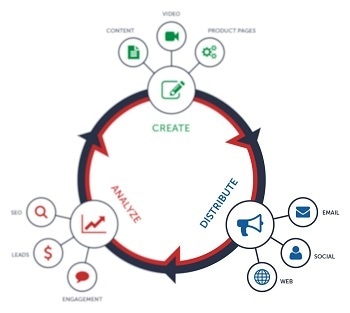Originally posted 9th March 2016

A few years ago, we had a Microscopy client who loved the idea of content marketing and wanted to distribute lots of content to a relevant audience. The only problem was, they didn't have the resources to create regular content... That was until we found a huge converted PDF tucked away on a back page of their site entitled "An Encyclopedia of Microscopy and its Applications".
We took the PDF (which, because it was old, they thought it irrelevant) and we re-packaged it into lots of digestible sub-sections which were not only easy to read, but also easy to find in Google.
The next 12 months saw 87 leads generated from that one "old and irrelevant" handbook and it still continues to generate leads to this day!
Content is the most important factor
As many as 93% of B2B marketers use Web content to find and nurture prospects. Content marketing costs 62% less than conventional marketing and can generate as much as 300% more leads.
Content Marketing costs 62% less than traditional marketing
YOY traffic growth is almost eight times higher for content creation leaders than for brands that follow in their wake. That means generating unique content has clear bottom line impact.
If Content is King, Distribution is Queen

Distribution is key to any content marketing strategy
But generating quality content is only half the battle. There is plenty of evidence to suggest why you should spend 50% of your resources on the distribution of content.
As in the above Microscopy example, they had a tremendously helpful resource that was just tucked away within the depths of their site... but no-one knew it was there!
Your own website is the ultimate platform for showcasing your content. But—there is a but!—if you develop great content and do nothing but post on your own site, you’re not maximizing ROI.
Good content has three goals:
- Engage and attract unknown visitors and prospects by providing expert answers to their questions.
- Capture user data by turning unknown visitors into leads.
- Convert and close customers by helping to solve their problems.
When you reach any of these goals, it strengthens your brand as a thought leader. When you hit all three, the combination is hard to beat ... even for established rivals.
Now we have established the need for useful quality content let's take a look at the best ways of making it reach a wide yet relevant audience.
Google and SEO
Google rankings are trusted, organic, and low-cost—on average, people believe sites with high Google ranks have a right to be there, with almost 35% of traffic going to search result #1.

Learn More: Google Updates Explained
Google has always strived to serve the best results to the user. Over the years through a mixture of unethical blackhat SEO tactics (i.e. link-building or keyword stuffing) or ethical whitehat (quality content creation) people have tried to influence rankings to appear top for their chosen keywords.
With each algorithm update, Google has become increasingly sophisticated with how it serves the most relevant content - We are now at a stage where the only way to "Game" Google's quality signals into ranking you highly is to actually spend time creating high quality content!
Achieving visibility on Google is a long-term goal that takes time. Although you might have a mix of methods and channels for your content, Google, quality content and SEO should always be in your mind. Check out our recent piece Top 10 SEO Tips for the Scientific Marketer.
Managed well, Google means virtually free traffic—but other methods work alongside it.
Press Releases and Public Relations
The days of paid press release sites as your main—or only—distribution strategy are over. Press Releases are an effective tool when used to convey useful, interesting or valuable trade knowledge and information to a captive audience, but by their very duplicitous nature, they will not rank well organically. Press release sites endured a huge drop in search ranking in 2014 following the Panda quality update and aren’t likely to come back soon.
That “Other” Massive Search Engine—YouTube

Learn More: Why Video is Taking Over
YouTube—not surprisingly, a Google property itself—is now the #2 largest search engine worldwide behind the Big G. It handles over 36 billion searches yearly, many for “how-to” videos.
We recently covered a piece on Why Video is Taking Over... That’s not surprising, considering the rising share of mobile devices—perfect for video—in the B2B decision-making process. 42% of decision-makers surveyed said they use mobile to get product information.
YouTube not only puts your content in front of its audience, but makes it highly shareable too.
With search engines putting more emphasis on quality, unique content, video is a great way to enhance the experience both for the user and
Social Media Amplifies Everything You Do ...
... positive or negative. So, it pays to make an effort to contribute to the conversation.
According to Pew Research, almost 65% of U.S. adults use social media. That’s a 10-year growth of 7%. With more millennials than ever in the workplace, and the advance of Social Selling now even reaching the scientific and industrial sectors, odds are your customers will have gone social.
Making content socially shareable means your network will be more likely to amplify your voice. Truly shareable content has a clear purpose, an effective headline and images, and unique value to add.
Social Media shouldn't be thought of as just a free channel. You can use paid promotion to hyper-target audiences according to their job role, industry, company size, interests, academic background and much more.
Email Marketing Brings it All Together

Learn More: 6 Email Tips for the Scientific Marketer
Web content is the most efficient way to get your prospects to trade contact information for information they value. Once you have that information, it’s important to put it to good use.
Decision-makers are naturally wary of vendors’ email lists, we have seen a real shift from mass email to incredibly focused, niche subject areas.
In fact, the countdown has begun to May 2018 where specific EU data regulation law will become applicable with hefty fines for non-compliance. Make sure you are across and compliant with:
- The opt-in process
- The definition of clear consent
When you make it a priority to push insightful, useful content to a receptive "opt-in" audience, you build rapport and make future sales more likely.
Re-package existing content
You've done the research, you've collected the data, you have created the content and then just waited for it to generate traffic and leads...
Your customer may not necessarily consume your content in one specific way - There is a huge amount of value to be extracted from re-packaging or repurposing content across a variety of formats. Transcribe a video interview into a written piece for your blog, turn a webinar into an infographic, take a keynote presentation and deliver it as an eBook or a slideshare.
Remember the Microscopy Encyclopedia? Make them into articles and blog pieces... There are a number of different ways you can re-badge and re-purpose existing content. You've done the hard work, now get distributing!
The Bottom Line
Digital marketing can be challenging, but it can work for you once you know the rules. Deliver excellent content via a strong mix of distribution channels and your prospects will come to you.
Drop us a line or get in touch to see how we can help your content go further.